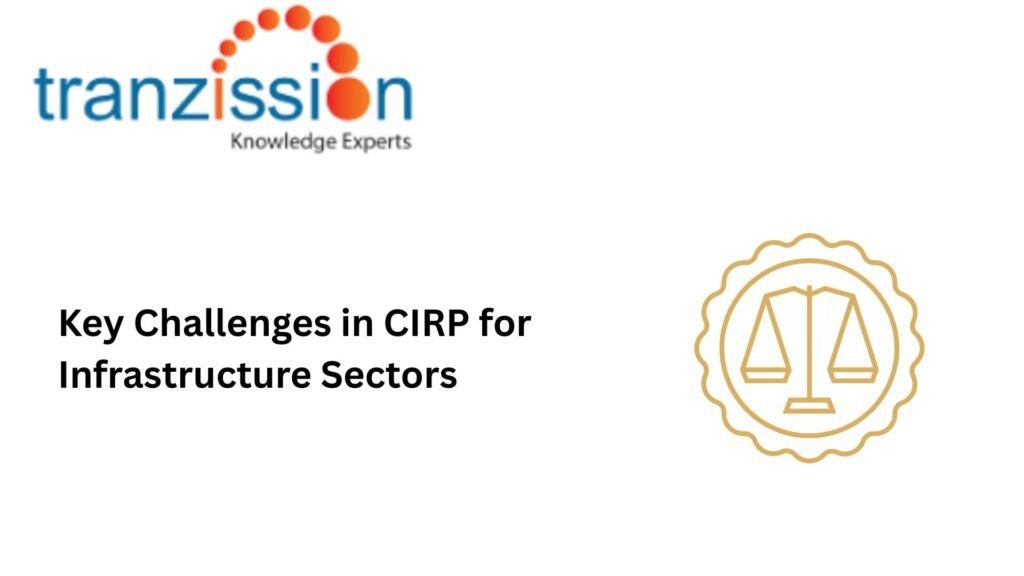
Key Challenges in CIRP for Infrastructure Sectors

Table of Contents
The issue of economic downturns that impact the financial situation of different industries, such as construction companies, cannot be ignored due to their contribution to the overall economy in India. Their delayed payments severely affect the cash flow disruptions, particularly in large corporations. The current insolvency framework in India may not address the distinctive obstacles that the infrastructure sectors may have during the process. This article delves into the legal issues in the insolvency proceedings in CIRP for Infrastructure Sectors , judicial precedents that may clarify such challenges and any new development that may have been introduced.
Why Infrastructure Sectors Face Unique Challenges in CIRP?
The contracts in the infrastructure sector are long-term, therefore it is likely for a company to get into financial difficulties during the contract’s duration, due to a number of factors.
Read more : Understanding the Interplay between Insolvency Law and Contract Law
The Role of Infrastructure in the Economy:
Infrastructure is important for economic development because it helps in job creation, improves productivity, and attracts investment. Therefore, large infrastructure sectors, such as power, roads, and telecom contribute to economic growth. The insolvency in these sectors negatively affects the economy, employment, and creditors.
Characteristics of Infrastructure Projects that Complicate CIRP:
There are unique attributes of infrastructure projects like high capital investment long payback periods, and complex contractual obligations, often involving public-private partnerships (PPPs). During CIRP for Infrastructure Sectors, these industries have to rely on external factors like government policies, land acquisition, and environmental clearances.
Key Challenges in CIRP for Infrastructure Sectors
Infrastructure sectors face specific challenges in the insolvency process regarding the legal process, financial aspects, and operational hindrances:
Legal Challenges:
The Insolvency and Bankruptcy Code, 2016 (IBC) provides a resolution process that applies to all insolvency cases. Therefore, there are several difficulties in applying the IBC to infrastructure projects and there is a lack of clarity in the treatment of concession agreements and termination clauses. Due to the complexity of such matters, there are jurisdictional overlaps with sectoral regulators, like the National Company Law Tribunal (NCLT) under the IBC, the Central Electricity Regulatory Commission (CERC), and the Real Estate Regulatory Authority (RERA) in land insolvency matters. Such issues complicate the legal procedures and delay the resolution process. Therefore, there is a need for specialized resolution frameworks for infrastructure assets.
Financial Challenges:
The financial structure of infrastructure projects creates barriers in insolvency cases, as it includes factors such as limited access to long-term funding, high interest rates, regulatory barriers, and land acquisition issues. These products are funded through high levels of debt, making creditors more vulnerable. It also includes valuation challenges due to long-term revenue generation and project-specific risks.
Read more : Implications of Public Policy in the Insolvency Process
Operational Challenges:
Operational challenges during the CIRP for Infrastructure Sectors are the delays in the process due to litigation and appeals, difficulty in valuing complex assets, challenges in managing stakeholders, and potential asset depreciation. Due to these issues, it becomes difficult to maintain the continuity of infrastructure projects during CIRP. Further, there may be hindrances in attracting resolution applicants due to regulatory and contractual uncertainties. It also includes stranded assets, assets that lose value or become liabilities before the end of their expected economic life, which does not appeal to potential investors. This affects the outcome of the resolution process, as potential buyers or investors are not interested in the recovery of the corporate debtor.
Trends and Strategic Improvements in India’s CIRP Framework
Recent Amendments and Their Impacts:
The pre-packaged insolvency process, established through the Insolvency and Bankruptcy (Amendment) Act, 2021, introduced a mechanism for the redressal of corporate debtors which are micro, small, and medium enterprises (MSMEs). The Amendment Act of 2018 recognises homebuyers as financial creditors, giving them representation on the Committee of Creditors. This ensures that the rights of homebuyers are properly addressed in real estate insolvency matters.
Recommendations for Revamping the CIRP Framework:
The complexity of infrastructure insolvency cases delays the resolution process. To reduce these delays, it is important to encourage continuous hearings to reduce multiple adjournments, and expedite the process, implementing fast-track procedures may decrease extension of time and procedural irregularities, and introduce pre-packaged solutions for large companies as well.
Best Practices for Insolvency Professionals in the Infrastructure Sector
Insolvency professionals act as neutral intermediaries and manage the distressed company’s operations. Their specialised knowledge of financial analysis and corporate restructuring to navigate complex insolvency situations of infrastructure sectors. As a resolution professional, they facilitate communication between the company and its creditors and negotiate with the creditors to reach a viable resolution plan. It is important for insolvency professionals, and crucial for aspirants to understand, to conduct due diligence for infrastructure companies undergoing CIRP for Infrastructure Sectors, and adhere to the IBC provisions.
Case Studies and Real-World Examples
The Pioneer Urban Land Infrastructure Ltd. v. Govindan Raghavan deals with the insolvency matter in development projects. In this case, there was an inordinate delay in the handing over of the flat and a failure to abide by the contractual obligation of giving the occupancy certificate. The Supreme Court held when there is an inordinate delay in the handing over of possession, the consumer is entitled to compensation for the delay. Jurisdiction overlaps are also an issue of the insolvency of infrastructure sectors. The IBC prevails over the Telecom Service Regulatory Authority of India (TRAI) Act, according to the National Company Law Appellate Tribunal. These cases highlight the unique nature of the infrastructure sector insolvency cases.
Conclusion
The IBC needs to be reformed to address CIRP for Infrastructure Sectors challenges in infrastructure sectors for better economic outcomes. Having a tailored approach to sector-specific matters can improve the delays in the resolution process and conflicts among different stakeholders, possibly reducing jurisdictional conflicts. It is pertinent that there are specific steps aimed to ensure the timeline set out in the IBC is honoured and unnecessary delays in the insolvency of infrastructure sectors are avoided. It is recommended to introduce a collaborative framework involving regulators, creditors, and industry experts to ensure that the resolution process adheres to the IBC, balances the interests of all stakeholders, and ends in the revival of corporate debtors.





